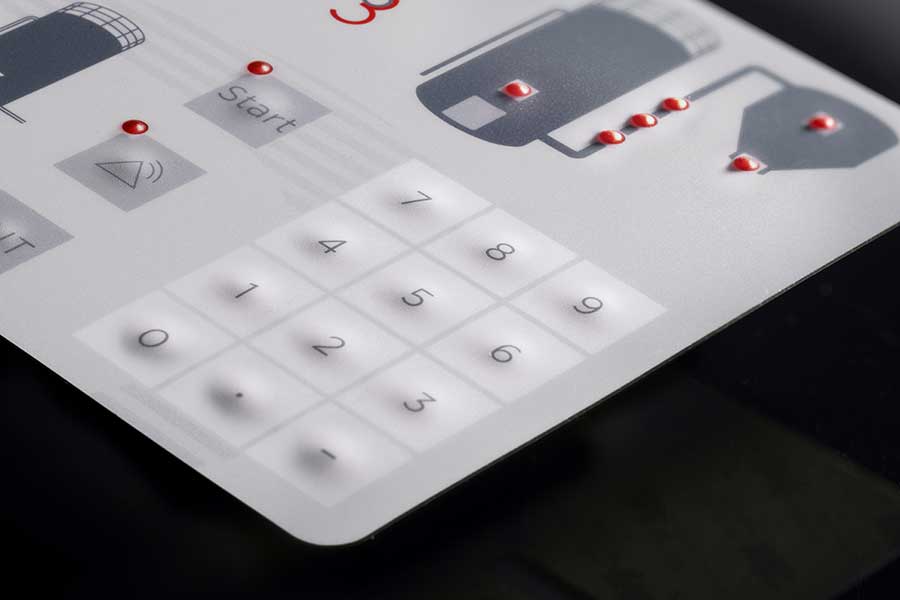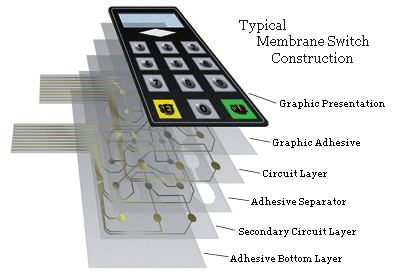Choosing a local membrane switch manufacturer can cut down on lead times and shipping costs.
Choosing a local membrane switch manufacturer can cut down on lead times and shipping costs.
Blog Article
All About Membrane Layer Switch: Recognizing Its Layout and Functionality
When you think about the control user interfaces in modern-day devices, membrane layer switches commonly come to mind. Allow's discover what collections membrane changes apart from various other control systems.
What Are Membrane Switches?

Their seamless nature makes them easy to tidy and resistant to dirt and wetness, a crucial function in many settings. Membrane switches can likewise be tailored regarding form, dimension, and graphics, permitting manufacturers to develop special interfaces customized to details products. Plus, they're light-weight and slim, which aids in lessening the general bulk of gadgets. Overall, membrane layer switches play a significant function in enhancing individual experience throughout a broad array of applications.
How Membrane Changes Work
When you push a secret on a membrane layer switch, it activates a straightforward yet efficient device. The leading layer, usually made of flexible material, presses down onto a conductive layer under it. This action bridges the void in between conductive traces, completing an electrical circuit. As quickly as the circuit shuts, it sends a signal to the device's controller, which analyzes your input.
You'll observe that the responsive feedback varies based on the button design, supplying either a soft click or a more obvious reaction. Once you launch the secret, the membrane layer returns to its initial placement, reopening the circuit and quiting the signal. This procedure happens virtually immediately, ensuring a responsive customer experience.
Membrane layer switches are preferred because of their longevity and resistance to dust and dampness, making them ideal for various applications, from home appliances to medical tools. Recognizing this procedure assists you value their prevalent usage.
Secret Parts of Membrane Layer Buttons
Recognizing the vital parts of membrane switches is essential for understanding their functionality and style. The protective layer guards against ecological aspects and put on, prolonging the button's life-span. By recognizing these parts, you'll obtain insight into how membrane layer switches over operate and their relevance in different applications.
Products Used in Membrane Layer Change Design
The performance and longevity of membrane layer switches greatly rely on the materials used in their design. You usually run into polyester and polycarbonate as main substrates because of their outstanding toughness and flexibility. These products resist scrapes and chemicals, making them excellent for demanding environments.
The conductive layers commonly utilize silver or carbon, picked for their reliability and conductivity. membrane switch manufacturer. Silver offers premium performance, while carbon is an affordable option. For the overlay, you may consider a matte or shiny surface, depending on your visual requirements and user experience
Adhesives play a crucial duty also; they bond layers securely and assure longevity. Make sure to choose adhesives that withstand environmental factors like temperature and humidity. Do not forget the importance of an excellent printing method for graphics, as it boosts both capability and visual allure. Picking the ideal products will assure your membrane button stands the examination of time.
Style Considerations for Membrane Layer Buttons
While developing membrane switches, it's crucial to take into account various elements that influence their functionality and customer experience. Start by concentrating on the design and button size; make particular they're user-friendly and very easy to browse.
Do not overlook the graphic style; clear labeling and color comparison are substantial for presence. Confirm your layout suits environmental aspects, like moisture or temperature variants, which can affect performance. Ultimately, remember the value of screening models with real individuals to collect comments and make necessary modifications. This repetitive procedure assists you improve the design, validating it fulfills both functional and visual requirements efficiently. By meticulously thinking about these elements, you'll create a membrane switch that boosts functionality and complete satisfaction.
Applications of Membrane Layer Switches
Membrane layer switches are flexible components found in numerous applications, from industrial tools to consumer electronics. You'll see their influence in makers that call for sturdy user interfaces and in tools that take advantage of sleek designs. Understanding these applications aids you value the performance and practicality of membrane buttons in daily innovation.
Industrial Equipment Use
When you're looking to improve the performance of industrial devices, membrane switches supply a trusted service that incorporates sturdiness with user-friendly style. These buttons are best for harsh settings, giving resistance to dirt, moisture, and chemicals. Accept membrane switches to streamline your procedures and improve overall performance.
Consumer Electronic Devices Integration
In the domain of customer electronics, membrane layer buttons play a vital duty in improving user communication and gadget functionality. Membrane layer switches also ensure sturdiness and resistance to dust and wetness, extending the life-span of your electronic devices. By choosing membrane layer buttons, you boost not simply the capability but check this site out also the style of your tools, making everyday communications smooth and delightful.
Benefits and Downsides of Membrane Buttons
While membrane layer switches provide a range of benefits, they also come with some downsides that you must consider. One significant benefit is their compact design, making them perfect for space-constrained applications.

Nonetheless, there are negative aspects. Membrane layer switches can have a much shorter lifespan compared to mechanical switches, specifically under hefty use. They can also be less responsive, which may influence customer responses throughout procedure. If harmed, repairing them can be difficult and frequently calls for full replacement. Inevitably, you can try these out their level of sensitivity to extreme temperature levels and environmental problems may limit their performance in particular setups. Stabilizing these pros and cons will certainly assist you establish if membrane buttons are the best suitable for your task.
Regularly Asked Concerns
How Much Time Do Membrane Layer Switches Usually Last?
Membrane switches over usually last in between 5 to ten years, depending upon usage and environmental conditions. You'll intend to assess elements like wear, direct exposure to moisture, and temperature level changes to determine their durability properly.
Can Membrane Switches Over Be Custom-made for Particular Designs?
Yes, you can customize membrane switches to fit particular designs (membrane switch manufacturer). You'll have the liberty to select colors, shapes, and designs that match your task's demands, ensuring they mix seamlessly with your general aesthetic
What Is the Expense Array for Membrane Layer Change Production?
The expense range for membrane layer switch manufacturing commonly drops in between $1 and $10 per system, depending on variables like design intricacy, amount, and products. You can obtain quotes from makers to find the very best alternative.

Are Membrane Switches Over Water-proof or Immune?
Membrane buttons can be created to be waterproof or resistant, relying on products used and construction approaches. If you need them for wet atmospheres, ensure you specify those needs throughout the style process.
How Do Membrane Changes Compare to Traditional Buttons?
Membrane layer switches are usually thinner and extra flexible than typical buttons, providing a smooth style. They're often less complicated to redirected here clean up and incorporate, yet might not supply the tactile responses you're made use of to with mechanical options.
Final thought

Report this page